Home Decor
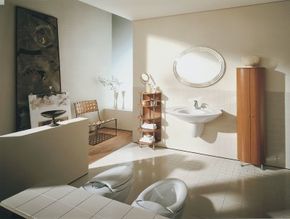
When it comes to home design, bathrooms are frequently overlooked and given low priority. During a renovation, the bathroom is often left behind as other public spaces like the kitchen take precedence. However, this doesn’t have to be the case. Each popular decorating style can be adapted for the bathroom, and it’s the perfect place to indulge in styles that differ from those in the rest of your home. Why not create a romantic sanctuary in your bathroom or a tropical aquarium for your kids’ bathroom? You might even want to give your powder room a more adventurous or opulent look than the rest of your house. This article provides a variety of bathroom design ideas to inspire you.
Before starting any bathroom project, it’s important to carefully plan. Take the time to consider practical points.
Natural materials provide texture, depth, and luxury to any room, particularly the bathroom. Learn how to incorporate wood, stone, and tile to create the perfect ranch-style bathroom.
Combine different styles with safety and accessibility features to create a bathroom that will serve you throughout all stages of life. Find tips to help you design a bathroom that is both safe and appealing.
A treasured item or heirloom can serve as the basis for your entire bathroom design. See a great example with this Pan-Asian bathroom inspired by a Japanese jewelry box.
Don’t be afraid of bold colors in your bathroom design. Check out these rustic bathrooms to see how a splash of color can highlight unique features.
Ancient Roman bathhouses offer timeless elegance. Find inspiration for capturing that spirit while maintaining modern comforts.
A bathroom with a single-color design and carefully chosen accent pieces can become a tranquil oasis. Check out this beautifully blue bathroom and find inspiration for your own color scheme.
This white-on-white bathroom design is anything but boring! With carefully chosen accent pieces, the white theme pops with crisp clarity.
Using a distinctive architectural feature or piece of furniture as a focal point is a great way to unify your bathroom design. Get ideas and tips to help you define a focal point in your own bathroom.
You don’t have to kiss a lot of frogs to create a bathroom with the charm and spirit of a fairy tale. Explore this French-style room to find ideas for imbuing your own bathroom with character.
Love is in the air in this opulent and flattering bathroom. No matter how small your bathroom space may be, you can always find room for romance. Get inspired to capture the essence of romantic style in your own bathroom.
Classic design never goes out of style.
Looking for a bathroom design that captures the elegance, balance, and regal appearance of ancient times? Look no further than this design, which draws inspiration from both Napoleon’s Empire and the Roman Empire.
Contemporary bathroom designs come in a variety of styles, including California spa, Scandinavian, Art Deco, and retro. Understanding the characteristics of modern styles can help you narrow down your choices when designing your bathroom.
Don’t think that you need a large bathroom to have a modern, open space with clean lines and urban design. There are ways to create this look and feel even in small bathrooms.
Bring the outdoors inside with natural materials such as hardwood. This magical grotto bathroom design offers inspiration for incorporating nature into your own bathroom decor.
Use soft complementary colors to create a warm glow in your bathroom. This contemporary soft yellow and plum bathroom design is a great example of how color choice can define the character of your bathroom.
Minimalist designs inspired by Asian cultures can create a peaceful, zen-like atmosphere in your bathroom. Embrace the serenity of these designs and find ways to incorporate them into your own space.
On a limited budget? Use color to make a big impact in your bathroom design. Learn how using a limited range of your favorite color can turn your bathroom into a standout sensation.
The materials you choose can make a big difference in the drama and texture of your bathroom. This bathroom design uses natural tiles and wood to add rich color and striking texture.
To add personality to a minimalist bathroom design, add accents in a couple of different colors. This will keep the design from feeling too cold or sterile.
In these bathroom designs, the toilets, sinks, and tubs are works of art. With flowing lines and sculptural curves, these bathrooms are both unique and welcoming.
Natural tile meets minimalist function in this design, which showcases the incredible variety of style that tile can offer.
Create a castle-like atmosphere in your bathroom with stone materials. This design offers inspiration for incorporating stone into your own bathroom design.
Glass can be used in a variety of ways to make a small bathroom feel larger and brighter. Get several ideas for incorporating glass into your bathroom design.
Take advantage of natural light sources to accent your bathroom design. This design offers ideas for window styles and shows how light can create a relaxing bathroom retreat.
Create an aquatic paradise with sea-inspired blues and greens. This minimalist bathroom design offers inspiration for turning your bathroom into an ocean oasis.
Even tight spaces can be streamlined and made to feel open and welcoming. This design offers ideas for maximizing space in a small bathroom.
If you have a small bathroom, don’t worry – you can still have great design. A streamlined design can help make the most of your available space. Adding focal points like mosaic tile features can give your bathroom a more interesting look. Make the most of classic white fixtures by adding strategically placed brightly colored features. Transitional style combines traditional and contemporary elements for a personalized design. Mixing traditional style with mostly white pieces and carefully chosen accents can create a fresh look. Modern artistic features, like aqua tiles, can update a traditional bathroom. European transitional design mixes old-world elegance with modern touches. Bold geometric patterns can take a traditional bathroom to the next level. When redesigning your bathroom, decide on a color scheme and visual theme and use them consistently throughout the room. Repeat each major color at least three times to create a cohesive look. With a little imagination, permanent fixtures can adapt to fit your overall home style.
This bath, designed in the style of an Italian villa, features border tiles in a Greek key pattern and corbel-style supports for the sink. A homeowner on a budget with a color palette of celadon green and rose transformed their master bath into an “English Caribbean retreat” by incorporating a watercolor scheme of sand, violet, aqua, and lemon. While creativity is important, practicality should not be overlooked. Safety should never be sacrificed for style. Avoid sharp corners, tubs without handrails, and non-slip-resistant floors and bath rugs. Plan for the long term by incorporating universal-design products and layout ideas. Keep the decor simple and clutter-free with closed storage options. Spend money where it counts, but consider ways to save in areas that don’t affect function, safety, or looks. Demand the same quality and taste in bath accessories as you do for the rest of your home.
While impulse items can still be found in bazaars and gift shops, there are now more sophisticated ways to create a romantic bathroom. For a sleek, modern look, choose high-quality materials such as acrylic, plastic, metal, or glass. Well-made acrylic accessories with a sea glass appearance or colorful metal items with a 1950s drink set vibe are both attractive options.

Modern-style items made in Italy, Sweden, Denmark, and the United States are generally reliable at various price points. Those designed in these countries but manufactured elsewhere are often less expensive. However, modern styles do not age well unless done well, so attention to detail is necessary.
Even if you have a glass shower door or open-area shower, you will need fabrics such as towels, bath mats, and rugs. Choose quality pieces with permanent textures and solution-dyed colors that will not fade unevenly. Towels and rugs can enhance a color scheme, so take advantage of white sales to stock up on necessary items.
Children’s Bathrooms
While it may be tempting to create a spectacular theme bathroom for your children, it is best to limit the fantasy elements to easily changeable items such as wall-covering borders rather than installed tiles. Choose timeless, gender-neutral colors that pair well with other tones and mix in new patterns as children grow.
Redecorating a child’s bathroom three times is common, so keep permanent fixtures and surfacing materials in mind. A child’s bathroom may later become a guest bathroom, so plan accordingly.
For a ranch-style bathroom, a sculptural, timeless design with strong, simple materials such as weathered wood, rough-cut stone, and strategically placed beams can create a contemporary yet comfortable mood. A knotty pine vanity and a weathered washed tub surround can blend into the walls of a Southwest-inspired bath with a stunning view. Rustic style can be sophisticated and easy to live with.
Bathroom Design Idea: Ranch Style
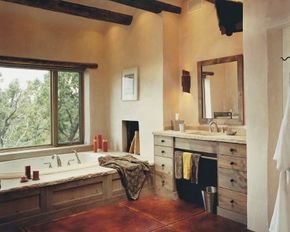
To create a personalized and comfortable bathroom design, it is important to mix styles. The following section showcases a fusion of artistic styles.
Bathroom Design Idea: Artistic Styling
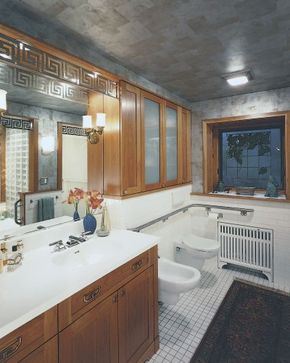
The bathroom’s safety features blend seamlessly with the overall design. The 1950s-era bathroom underwent a complete makeover to modernize its appearance and safety features. The outcome is a room that reflects a simple Arts & Crafts-inspired design with subtle Asian influences, without looking institutional. This bathroom is a prime example of universal access within a sophisticated decorative scheme. It has up-to-date features that offer safety and performance, Asian antiques that enrich the overall look, and thoughtful elements throughout.
By annexing two feet of extra width from an adjacent closet, the bathroom features separate bathing and showering functions, as recommended by safety experts. The grab bars and rails, some custom, some stock, are positioned in all the right places without being intrusive. The wall-hung toilet and bidet are accessible from a wheelchair if required, and a custom support rail is both functional and stylish. The whirlpool tub is sub-mounted to a solid-surfacing platform, eliminating the obstruction of a tub lip. The bathroom also has grab rails for safety and lever-handled faucets for easy manipulation.
The Asian-inspired wall-covering with a soft metallic finish adds depth and interest to the walls and ceiling, making the room universally appealing and accessible. The Asian-inspired features complement different styles, making the bathroom versatile. To learn more about Asian-inspired bathroom design, see the next section.
Bathroom Design Idea: Pan-Asian
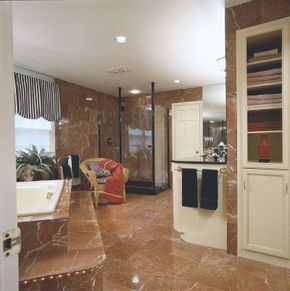
This stylish bathroom mixes colors, textures, and styles to create an attractive effect. Using colors from different cultures, such as the pale pink of English cabbage roses or Asian porcelain, can help develop a new color scheme for a bathroom. The inlaid Japanese jewelry box inspired this bathroom, which now boasts a wealth of style and amenities. It’s hard to believe that this lavish family-size master bathroom was once a small bath and studio.
In addition to making a personal statement, this bathroom is an example of the power of color. Warm, earth-tone marble makes the space as visually cozy as a wood-paneled library, without sacrificing the cool gleam the luxurious stone provides. The lighting is also inventive and clever, with a row of brass-and-glass mirror sconces that illuminate the scene without disturbing the masterfully simple look of the space. Tiny “running lights” in tubes surround the tub’s marble base, creating a fun, romantic ambiance at night.
The color palette draws inspiration from the East and includes ebony, ivory, and cinnabar, the dark red-orange color of an ancient Asian lacquer. The vase tucked into one of the storage shelves showcases a fine example of the painstaking craft. If you’re looking for a bold and colorful bathroom design, see the next page to learn how deep colors can be used effectively in a lodge-style bathroom.

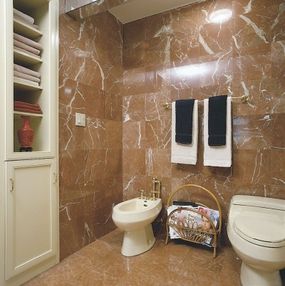


Bathroom Design Inspiration: Lodge Style

This unique bathroom design features a vintage-style bathtub in a bold crimson red color, setting a confident tone for the entire space. While most lodge-style rooms tend to incorporate earthy tones of green, brown, and gold, these bathrooms take a daring approach with knockout colors like bright red and cobalt blue. Surprisingly, these colors blend perfectly with the predominant wooden tones, creating a well-balanced triadic scheme of the primary colors: red, yellow, and blue. In addition to the bold colors, these rustic bathrooms also share a practical use of surfacing materials, like wood floors and walls, fieldstone walls, and white ceramic floor tiles. A royal blue sofa and red vanity add extra pops of color to the golden-hued log walls.
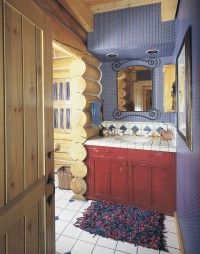
The second bathroom design features a vintage red tub alongside a contemporary glass-block panel. The panel evokes the small window panes of old, especially when set into a wall paved in fieldstone. White ceramic floor tiles offer visual refreshment and easy maintenance. A sink alcove in a cheerful blue-striped wall-covering gets an extra punch of color from a red vanity with a scuffed, distressed finish. A modern rag rug in blue and red reinforces the whimsical look of the curly iron-framed mirror. Meanwhile, the third bathroom is tucked into a discreet corner, featuring a one-piece toilet and double-sink vanity. The vanity cabinet is crafted in rustic knotty pine and topped by deep cobalt blue ceramic tiles. Rosy red wall-covering and a Spanish-inspired mirror add warmth and sparkle.

The lodge-style bathroom design incorporates bold colors and intriguing shapes. Decorative accessories from colonial Spanish to Southwest Native American add a spark of flair to these naturally dramatic spaces. The effect is a tribute to the romance of the Old West, rejuvenated with a bracing jolt of contemporary style. These rooms perfectly blend the past with the amenities of the present.
Bathroom Design Inspiration: Middle Ages Style

Ceramic tile has been admired for its durability, brilliant color, and shine since ancient times. This bathroom design pays homage to the beauty of tile with a look that evokes the romance of ancient and medieval days. The space features a mix of small glossy blue and green tiles, medium-size tiles in earthy ombré tones, and large tiles in pale, neutral tones with intricate traditional motifs. The visual effect is layered, rich, and dazzling in a surprisingly subtle way. It looks like an archaeological find from an ancient bathhouse, with allusions to Byzantine and Moorish Spanish cultures, among others.
The private enclave of the sunken tub area is beckoning with a glass door featuring a scrolled brass handle and arched, open top. The tub area is adorned with a row of small, beautifully proportioned windows repeating the arch motif. Once inside, the bather enters another world, feeling as if they are in an ancient grotto pool. The sunken tub is surrounded by larger tiles in warm-hued umber and lined with small stone blue tiles. The arched windows let in ample light without compromising privacy and add to the ancient, romantic atmosphere. Although not Pompeii, it is still a treasure trove of timeless design ideas.
For a more modern take on a traditional bathroom design, check out the next page for a simple and luxurious design idea. The low-key luxury bathroom design features a white and blue color scheme with gold accents. The ornately embellished tub is the focal point of the bathroom and is sure to impress. The rich blue background highlights the neutrals, making them shine and giving the room a cheerful and romantic feel. If blue is not your color, try this design with another color to achieve the same sophisticated and luscious look.
If you prefer a predominantly white bathroom design, the white-on-white bathroom design on the next page might just be what you’re looking for. The king-size master bath exudes an air of well-bred, quiet luxury with deftly understated touches. The white-on-white scheme renders even the most whimsical elements witty rather than cutesy. The ivory wall-covering and coordinating oyster white tile vanity trim are beautifully textured for a quiet opulence. The teak and white wood tub surround evokes classic architecture and the timeless appeal of ships, while the custom-made bathroom cabinets trimmed in bamboo add a subtly exotic touch.

The shower stall is decorated with accent tiles featuring shells, sand dollars, and starfish, which adds to its charm. The tiles are white-on-white with classic rope and marine-life designs. Unlacquered brass fittings and a built-in seat made of polished stone with soft mottling enhance the underwater theme. The signature elements give the shower a seaworthy look without being cliché. Regardless of the color scheme used, it is important for the bathroom design to revolve around a distinctive focal point. For more information about finding a focal point, refer to the next page.
Bathroom Design Idea: Finding a Focal Point

The vanity in this master bathroom is a showstopper with its superbly matched wood grains and intricate ebony detailing. It may be challenging for viewers to identify just one focal point in this spacious bathroom. Incorporating one or more focal points is a simple way to add interest to any bathroom design. The mirrored wall with gleaming chandelier sconces and the spectacular vanity with its pair of crystal sconces are both eye-catching, but the marble-surrounded tub with its window view flanked by classic oval windows is also undeniably impressive. Extending the tub’s marble surround onto nearby walls gives the room a sleek, flowing look and provides ample space for seating and stacking bath supplies.

This tub surround has a simple design in fine wood, but gains richness from the swirling grained marble top. Even if a bathroom is not large enough to have more than one focal point, one can still use some tips from this stunning room. If possible, position a large mirror opposite the window to capture all the light and the view. Installing vanity lighting right on or above the mirror adds more reflective sparkle. For an exquisite touch, find a vintage dresser and have it converted into a unique vanity, or decorate an ordinary vanity with special paint and hardware. A distinctive geographical style also adds visual drama to a bathroom design. To explore a bathroom with a French flair, refer to the next page.
Bathroom Design Idea: French Flair
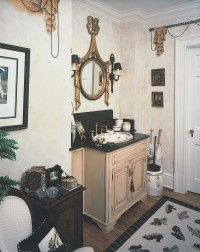
Enchanting details fill this French-style bath. The bathroom design is unmistakably French, with a refined yet not stuffy atmosphere that exudes chic spirit. This bathroom has a coquettish air reminiscent of Cinderella or Marie Antoinette. The painted drapery rod and swathe over the door complement the faux drapery on the vanity mirror. The powder room is filled with beguiling details straight out of a French fairy tale from the 1700s. The gilded wood mirror frame is echoed in the faux-painted drapery above the door, and a hand-painted sink adds panache. The key to keeping these decorating ideas from becoming cliché is by using sophisticated, largely neutral color schemes that are limited to a palette of white, cream, tan, brown, and black, with a hint of old rose.
When designing a bathroom, taking inspiration from a particular style or time period can result in a unique and charming space. For a more romantic bathroom, continue reading.
Bathroom Design Idea: A Romantic Getaway
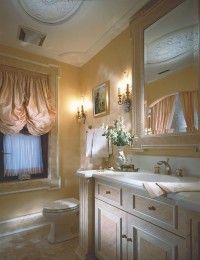
This bathroom exudes traditional elegance and romance.
This bathroom design uses a peach color scheme to create a romantic atmosphere. The room features basic fixtures, grand gestures, and a flattering color palette anchored by taupe and brown neutrals. The refined opulence is achieved with peach silk curtains, peach marble flooring, and a substantial vanity and mirror embellished with faux finishing in subtle peach-and-taupe tones. Coordinating faux-finished cabinets, pleated sheers, and silk balloon shades complete the romantic ambiance.
Regardless of your personal definition of “romantic” style, it can be created in any space, big or small. Don’t be afraid to try an over-the-top idea, whether it’s dramatic or whimsical, as it adds to the room’s mood. This is the essence of romantic style.
If you prefer a bathroom with cleaner lines and symmetry, check out the classic bathroom design on the next page, which takes inspiration from ancient Rome.
Bathroom Design Idea: Classic Design

This classic bathroom exudes grace and symmetry, reminiscent of ancient landmarks.
This stunning bathroom design has modern conveniences but draws inspiration from the elegant, many-layered past. The black-and-white-and-gold color scheme recalls the Empire period of Napoleon, which borrowed images and motifs from ancient Rome. The use of a columnar pedestal sink and architectural fragments as accessories is fitting for this space. The warm color palette adds dignity and vigor to this Empire-inspired bath, making any owner feel like royalty. Slender columns highlight the bathtub alcove, one of many clever allusions to classicism. In this bath, neutral colors show how rich and eloquent they can be, with light-capturing white and gold-framed artworks adding to the quietly opulent mood.
Contemporary style can be just as engaging as traditional or classic designs. For more information about contemporary design styles, continue reading.
Bathroom Design Idea: Contemporary Styling

This modern bathroom offers a spacious ambiance inspired by California spa designs.
Contemporary style encompasses a broad range of looks. “Modern” design officially began with Arts & Crafts/Mission styles in the early 20th century as a reaction to the ornate Victorian style. However, in the early 21st century, “modern” is commonly used to describe design icons from the 1930s to 1960s. “Contemporary” is a less structured concept and more of a lifestyle.
Contemporary bathrooms are cool and clean and can be casual or elegant. As bathrooms are often dominated by modern fixtures, many people choose contemporary style regardless of the rest of their home’s decor.
Contemporary style is characterized by simple and sculptural curves, squared-off angles, minimized surface details, and textures. It employs modern design elements like one-piece toilets, sleek built-ins, and minimal or simply shaped hardware. Some products in this style reveal their structure and function, while others reduce forms to their simplest expression. This style is easily incorporated into modern bathrooms, conveying a spirit of freshness and freedom. The glamorous modern bathroom design showcases the intelligent use of design concepts that work well in smaller rooms. Light tones and smooth textures on the vanity, walls, and flooring make any space look bigger. Frameless mirrors create a spacious and brighter atmosphere, and mirrored medicine cabinets offer storage and dazzle. Natural stone tiles pay tribute to the beauty of nature, creating an enchanted grotto or cavern-like feel.
Using a variety of tile sizes and shapes, including diagonal placement, enhances the visual drama of these patterned tiles. The bathroom features a wardrobe for storage and privacy, with fine hardwood and a granite top. A mirrored vanity niche reflects the stainless-steel sink and brushed-nickel fittings, with a frameless cabinet and beveled granite top. The use of small diamond-shaped tiles at chair-rail height and above keeps the room human-scaled, while metallic tiles add jewel-like accents. The warmth of the wood and coolness of the tiles make the bathroom inviting. To introduce warmth with color, a golden tone is used in the tiles and walls, with complementary colors of cantaloupe and plum. Semi-gloss walls in tangerine and plum add depth, with white fittings and accessories for contrast. A private toilet compartment provides good lighting, closed storage, and a rack for reading material.
To achieve a similar appearance, select two neighboring colors that you adore and balance them with their opposite colors. For a warm and cozy effect in your bathroom, opt for two soft shades, or choose deeper colors to infuse energy and vibrancy into the space.
If you are looking for a modern and sleek bathroom style, head to the next page for some excellent examples of cutting-edge designs.
The cutting-edge bathroom in the photos has an Asian influence, which creates a tranquil and serene atmosphere. Designing a contemporary bathroom requires a lot of thought, especially if you want to follow a minimalist aesthetic. Unlike traditional or transitional spaces that can be built up in layers, contemporary bathrooms need to be designed from the ground up.
It’s possible to create an impressive contemporary bathroom in a typical “white box” room, but it’s easier if you have an interesting architectural shell to work with. Interior designers and architects refer to this process as “getting the bones right first.”
The two bathrooms showcased here demonstrate the importance of architecture as the structural framework for modern designs. In one bathroom, a skylight window floods the space with light, while a dramatically angled wall provides strong areas of light and dark. Sculpturally inspired fixtures and mirrors add to the overall look.
In the other bathroom, every specific need of the owners was anticipated and accounted for in advance, with solutions built into the space. The bath has cubbyholes and cupboards aplenty to make basic bath storage part of the design of the space rather than something that intrudes on it. Deft touches, including a recessed light strip and unusually shaped windows, add to the interest.
If a minimalist aesthetic is not your style, try adding bold colors to make your bathroom more engaging. Head to the next page for ideas on integrating bright hues into your bathroom.
In this section, blue hues create dramatic backdrops for pure white fixtures, making for a striking bath. Fields of strong color played against bright white fixtures is a foolproof recipe for an exciting contemporary bathroom design. You can make a memorable statement just by painting the walls in one or two of your favorite vivid colors.
For the most striking look, choose two widely different colors, such as royal blue and lime. For a more subtle sense of depth, choose two adjacent colors like royal blue and violet or lime and leaf green. Against such strong hues, even the simplest white fixtures gleam with fresh importance.
If your budget allows, you can build up the look with installed materials that create pleasing variations on your color theme. This bathroom uses tiles in a mottled mix of related tones to create depth and interest within a limited color range. Silvery chrome and glass complete the modern look.
For a more understated, spa feeling, head to the next page to find a dramatic bathroom.
Dramatic Bathroom Design Idea
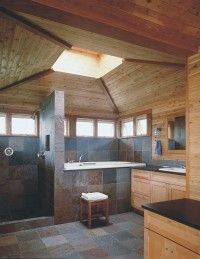
This bathroom design uses natural colors to create a rustic yet modern style. The master bath has an open layout to the master bedroom, allowing for a spacious retreat. The design incorporates a mix of textures with maple cabinets and knotty cedar walls and ceiling. The tiles in deep green, teal, umber, gold, and purple-gray, with their subtly textured, slightly lustrous surface, add a symphony of natural colors and textures. The skylight in the center of the ceiling puts the tub area in a natural spotlight, while the slate-textured tiles with a subtle sheen in earth tones create natural drama. The design is simple yet luxurious, achieving a minimalist look.
Minimalist Bathroom Design Idea

This bathroom design uses neutral colors and a minimalist decorating scheme, with plum accents adding warmth and interest. The crystal vases and silver-painted pottery add dramatic light-reflective elements without compromising the minimalist look. The repeated geometric theme is achieved with pale floor tiles, a textured glass-block window, and frameless, hardware-free cabinetry. The walls were ragged and glazed in layers of taupes and ivories to create an aged, faux-stone impression, adding warmth and depth to the space. Against the ivory-white surfaces, the bright accents of silver and warm accents of plum and taupe stand out dramatically. For a spare aesthetic with more warmth, consider a modern art design with horizontal lines and sculptural fixtures.
Modern Art as a Bathroom Design Idea

This modern bathroom has an artistic touch with unique fixtures and fittings.
When it comes to designing a modern bathroom, striking contemporary fixtures and fittings can be the perfect way to express your style. Even in larger bathrooms, these fixtures can create a pleasing sculptural effect.
One lime-green bathroom takes a unique approach, with the toilet and bidet mounted directly onto the cabinets for a seamless look. The wall-hung sink cabinet matches the style but offers a lighter feel. In another bathroom, horizontal lines and a calming blue wall provide a soothing backdrop for modern fixtures with smooth, flowing lines.
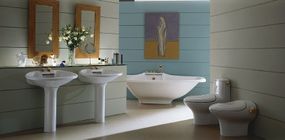
The flowing lines of the fixtures contrast nicely with the horizontal lines of the walls.
The fresh tones of lime green and aqua on the walls add to the lively ambiance of these bathrooms, while carefully selected pieces of contemporary art bring a sense of luxury and presence. Just be sure to keep the art away from water sources and use a good exhaust fan to prevent damage.
If you don’t have any art to display, start with an inexpensive print or a piece from a local art fair. In these bathrooms, art serves a functional purpose by complementing the minimalist philosophy that values useful items over clutter. For more examples of sleek, modern, minimalist bathrooms, continue to the next page.
The Clean-Cut Look as a Bathroom Design Idea

Textured, subtly colored tiles with a metallic sheen create a mesmerizing effect in this bathroom.
In a world filled with clutter, minimalism can be a refreshing approach to home design. By focusing only on beautiful and useful items, minimalist bathrooms can create a peaceful oasis. Two bathrooms in particular use tiles as a solution to achieve a clean-cut look that’s both sleek and easy to maintain.
Tiles may be a modern material, but they’ve been used in homes for centuries and impart a timeless, natural quality to any space. Varying colors, textures, and non-rectangular shapes can add interest to a minimalist design. For example, a small row of round tiles or a unique sink bowl can make a statement in an otherwise simple bathroom.

This austere bathroom has a serene and dignified look reminiscent of Asian design.
If you want to incorporate natural materials into your bathroom design, there are other options besides using tile. Stone, for example, can have a dramatic effect on the look and feel of the room. The use of natural stonework in a bathroom can create an opulent, cavernous retreat. In this contemporary bathroom design, a mix of bamboo, marble, limestone, and wood pay homage to nature. Glass and iron are also used to enhance the rustic dignity of the space. Limestone is used in small, painstakingly chiseled 1×3-inch tiles on the wall and in large crosscut tiles that face the tub. Pebble stone floors in the shower and bamboo strip flooring in the rest of the space add to the quiet richness of the bathroom. The tub and shower walls are covered in tempered glass and a neutral, 12×12-inch Peruvian stone in the same shades as the shower floor. Marble vanities add a sense of ancient elegance to the bathroom. Large tempered-glass windows in the tub and shower area open onto a small porch overlooking the mountains. If you have a small bathroom, incorporating glass into your design can help add more light and make it feel bigger. Translucent glass panels create a sense of privacy while enhancing the feeling of light and space. Using glass instead of traditional opaque wall partitions to divide the space can provide intriguing glimpses through to other areas and allow light to brighten the entire space. A clean, simple base of stone and glass sets off the varying colors of paintings, cushions, and most of all, flowers and plants.
Using Natural Light in Bathroom Design

This bathroom design incorporates modernity and comfort.
Despite the appeal of contemporary bathroom designs with clean lines, people often prefer bathrooms that offer a sense of comfort. This modern bathroom design provides thoughtful comforts along with a provocative design.
The bathroom feels more spacious than it is thanks to the breathtaking outdoor views. If you have a house with protected, private views, you could maximize them with picture windows or greenhouse windows that provide even more natural light.
The vanity is another attractive feature, crafted in an Art Deco style that is both modern and romantic. Classic sink fittings contribute to the sense that this piece is an heirloom from the 1930s.
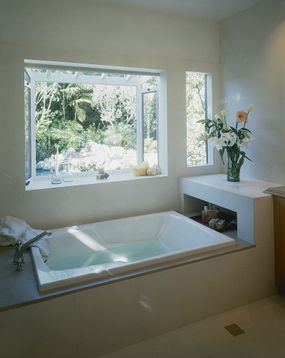
The bathtub is surrounded by natural light.
The bathtub has a cleverly designed two-tiered shelf that provides space for display above and room for storing bath supplies below. The greenhouse-style window acts as a great light scoop and offers a view of the secluded garden.

The bathroom has separate shower and toilet areas.
A separate compartment houses a urinal and a conventional low-profile toilet. Conveniently located glass shelves provide ample storage space.
If you are not planning to have scenic views and custom-crafted vanities, you can still create a modern-style bathroom by keeping things simple.
If you find the understated Art Deco look too traditional, consider creating a refreshing minimalist look in your bathroom. Turn to the next page for ideas on a cool blue bathroom.
Cool Blue Bathroom Design
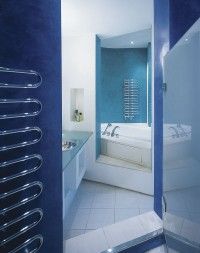
This blue bathroom design is perfect for relaxation.
Just imagine coming in on a hot day from the garden or tennis court and splashing cool water on your face in this bathroom, and you’ll know the essence of refreshment.
This bathroom is exquisitely engineered in virtually every detail, with green glass used for the vanity top and door, creating a pleasing “watery” image appropriate for a bath. Cobalt and turquoise blues continue the water image and add depth to the scene.
Curvy and shiny wall radiators have been chosen for maximum function and elegant form. They heat up the setting’s style while warming up the room.
The combination of curved and straight lines adds a subtle rhythm to this blue-and-white bathroom and keeps the minimalism from being too stark. A green glass door and coordinating vanity counter provide subtle color and luster. Niches cut into the wall and vanity base function as cubbyhole storage and add a little more zip to the architecture.
The bathroom boasts a stunning stainless-steel sink and a green glass counter-top which provides an aquatic energy to the space. A mirror above the sink adds more color to the room in an intriguing way. If you prefer a more serene bathroom, the next page features a neutral-colored oasis with soothing Japanese inspirations.
The article also provides tips for streamlining tight spaces in a bathroom. A townhouse in Greenwich Village designed for a composer, an artist, and their son features a modern bathroom design that honors the family’s Japanese heritage. The architect was able to create a 5-foot-4-inch tub, a separate shower and a double-sink vanity by interlocking units and using engineering tactics such as a tub surround that projects into a frameless shower to form a small ledge. Pocket doors and built-in storage shelves also help to maximize space.
In another bathroom design idea, the article suggests adding visual features to a neutral-toned bathroom. A curved wall of green glass and mosaic tiles provide visual enticements without disturbing the room’s mostly rectangular lines.
Overall, the article showcases modern and minimalist bathroom designs that functionally beautiful and provide a serene and open feeling.
The stone-framed bathtub is made more interesting with a curved wall section adorned with green mosaic tiles. The wall section also has a slender ribbon of etched glass, which resembles a cascading waterfall and alludes to nature. The vanity cabinet is crafted with precision and is a sleek and modern piece. The small green mosaic tiles on the tall and narrow mirror match the other strong vertical rectangles in the room. The overall effect is chic yet calming. On the next page, there are bathroom design ideas that incorporate bright colors and white fixtures. Although fixtures are available in various colors, white remains the preferred color in bathroom design. White fixtures are versatile and can match any colored wall, making it easy to switch up the color scheme. Additionally, white fixtures highlight the unique shapes of bath fixtures more interestingly. The transitional bathroom design style blends traditional and contemporary styles, creating a practical and exciting tension between old and new, rustic and elegant, and romantic and edgy. Transitional styles often use repetition of colors or patterns to create a mood and combine rustic and elegant elements that share a bond of color or mood. It is a sophisticated yet livable style.
The term “transitional” covers a range of styles, such as eclectic, Arts & Crafts/Mission, ethnic, and beach house styles. The key is to mix and match styles to make it your own. For a simple transitional style, go to the next page.
Bathroom Design Idea: Modernizing a Vintage Look
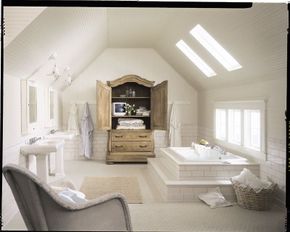
This bathroom’s French country armoire is the centerpiece that breaks up the monochromatic color scheme.
To achieve a transitional bathroom design, use plenty of white. Modern fixtures can complement traditional cabinetry if both are in white or pale neutral tones.
In the bathrooms featured here, white is the main color, creating a clean and romantic atmosphere. The only other colors are simple neutrals: the tan of a wicker basket, the soft brown of a weathered wood armoire, and the deeper brown of wood strip flooring.
One advantage of this concept is that white paint is available at all price points, and white tiles and fixtures are usually less expensive than colored or decorated ones (although white fittings may be costlier than chrome ones).
Moreover, the unity of white makes everything go together, regardless of their different styles or origins. Chic and peaceful, white is always a good choice.
You can be as creative as you like with a transitional bathroom design, even if you have vintage pieces. Go to the next page for an example of artistic transitional style.
Bathroom Design Idea: High Art

Aqua tiles on the walls and floor create a focal point.
A guest bathroom in a century-old home and studio of a prominent painter/sculptor was given an artistic bathroom design during a recent major renovation.
The space is a transitional-style gem, blending Gilded Age grandeur and Italian modernism into a surprising and serene haven. Every detail was carefully planned.
The room feels contemporary without being too trendy. The owner wanted to mix old and new in an artful way, and the architect happily obliged.
The vintage sink and extra-long cast-iron tub, along with a few new elements like the glass shelf and towel bar, create an impressive ensemble.
For the surfacing materials, a color scheme of aqua, antique gold, and rich brown was chosen for its timeless appeal.
The turquoise bath tiles may be a cliché, but not in this bathroom. These industrial-grade Italian floor tiles are cut randomly in trapezoidal shapes and splayed like a starburst from the room’s center point. Similar square and rectangular tiles are used on the shower wall.
Ancient design elements include walls hand-troweled with ocher-tinted plaster and a handsome sink with a fluted-column pedestal. Modern touches are provided by halogen lights piercing the wall.
If your bathroom has a more rustic look, you can combine it with contemporary features to create a personalized transitional design. See the next page for tips.
Bathroom Design Concept: Elegant Countryside

Combining modern minimalism with rustic materials creates a distinct atmosphere in this transitional bathroom design.
Although not small, this 10×11-foot bathroom uses a minimalist approach with carefully selected high-quality elements to create a unique design statement. These minimalist ideas can also be applied to smaller bathrooms, such as a typical 5×7-foot space.
The refined rusticity of this bathroom is achieved through the use of painted poplar walls, a slab slate tub surround, and salvaged antique chestnut wood for the vanity. These luxurious materials offer subtle colors and textures that enhance the tranquil atmosphere of the bathroom. If these materials are not within budget, painted walls, large slate tiles, and distressed oak can create a similar effect if installed with quality workmanship.
Aside from the surfacing materials, this bathroom also provides practical comforts, including an extra-deep soaking tub, double sinks with medicine chests, and separate glass-enclosed compartments for the toilet and shower.
The key to achieving a transitional design is finding a balance between traditional and contemporary features. Check out the next page for a bathroom design that exemplifies this balance.
Bathroom Design Concept: Harmonious Design
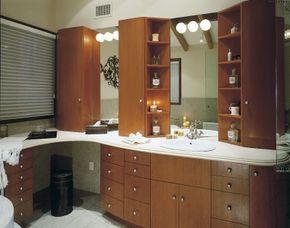
This transitional bathroom design exemplifies the timeless appeal of architectural design with quality materials and execution.
The focal points of this bathroom design are the dramatic oversize skylight, masterful vanity, and the decorative candle sconce. Each element, big or small, works together cohesively and elegantly.
The shower stall, generous in size, features a built-in seat and a frameless glass door that enhances the simple sculptural effect of the design. The vanity is a masterpiece of storage, with both open and closed compartments, and a sleek design that echoes the curved motif throughout the bathroom. The metal pulls add to the vanity’s Art Deco-inspired aesthetic.
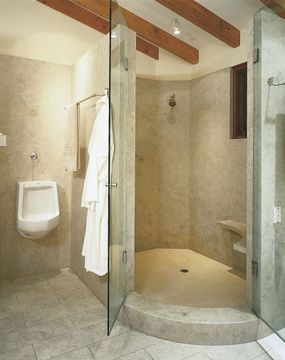
The luxurious rounded shower stall adds a touch of elegance to the bathroom.
The bathroom’s design is dynamic, with a series of repeated curves and squares in balance. Against this array of forthright shapes, the curly wall sconce, complete with real candles, adds a romantic contrast.
Whether big or small, your bathroom vanity should include as many open/display and closed/private storage compartments as possible, made with the best materials that fit your budget. This bathroom design offers plenty of ideas to inspire your own bathroom renovation.
If you have a small shower stall, it would be practical to add a built-in bench, even a pull-down model if space is limited. Fresh blooms and candles are also excellent accessories that would look great in any bathroom. Transitional design is perfect if you prefer an eclectic look rather than a defined style like Art Deco. Transitional style can be achieved by combining modern and traditional bathroom design elements or by balancing contemporary and traditional elements in an eclectic fashion. This style can have the best of both worlds, the simplicity of contemporary style and the elegance of traditional style. Transitional style is not just limited to American design but is also evident in European-inspired rooms. The European-inspired rooms have a uniquely rich form of transitional style, which is evident in the open spaces decorated with only a few grand gestures. Another way to create transitional style is to use bold patterns, such as geometric patterns. This masterful master bathroom design uses strong geometric patterns, a riot of stripes, triangles, and related shapes are combined and repeated to create an optical illusion of physical dimension on a flat plane and movement in an architectural space. The color scheme of neutrals, gold, brown, taupe-gray, white, and black gives a soothing effect. Regardless of how opulent your bath plan may be, it makes sense to aim for a winning look of restrained richness and focused energy. Whatever design you choose for your bathroom, make sure it’s within your budget and expectations.
Additional Information
Related Articles from HowStuffWorks
- Ideas for Decorating Your Kitchen
- Decorating Your Dining Room
- Home Decorating Tips and Tricks
- Ways to Decorate Your Home Spaces
- Interior Design Ideas
- Tips for Decorating Your Home
- Decorating Your Kids’ Rooms
- Different Decorating Styles to Try
- Bathroom Decor Ideas
- Ideas for Decorating Your Bathroom
- Creating a Bathroom Design
- Ways to Decorate Your Bathroom
- Decorating Ideas for Kids’ Bathrooms
About the Author
Mary Wynn Ryan is a well-known author of various interior design books, such as The Ultimate Kitchen, The Ultimate Bath, Cottage Style, Fresh Country Style, and Garden Style. She has contributed to several magazines on home furnishings and interior design and served as Midwest editor of Design Times magazine. Additionally, she was the director of consumer and trade marketing for the Chicago Merchandise Mart’s residential design center. At present, she is the president of Winning Ways Marketing, an editorial and marketing consulting firm that specializes in home design and decorating.
FAQ
1. What are some popular bathroom design trends?
Some popular bathroom design trends include minimalist designs, natural materials such as wood and stone, freestanding tubs, and bold accent walls. Another trend is incorporating smart technology into the bathroom, such as motion sensor faucets or voice-activated lighting.
2. How can I make a small bathroom look bigger?
You can make a small bathroom look bigger by using light colors on the walls and floors, installing a large mirror or multiple mirrors, and using open shelving instead of closed cabinets. Another trick is to use a clear glass shower door or a frameless shower enclosure to give the illusion of more space.
3. What types of flooring are best for bathrooms?
The best types of flooring for bathrooms are tile, vinyl, and laminate. These materials are water-resistant and can withstand high humidity levels. Another option is concrete or polished concrete, which is durable and easy to clean.
4. Is it better to have a shower or a bathtub in a bathroom?
It depends on your personal preferences and lifestyle. If you enjoy taking long baths, a bathtub may be the better choice for you. If you prefer quick showers or have a busy schedule, a shower may be more practical. Some bathrooms have both a shower and a bathtub, which offers the best of both worlds.
5. How can I add storage to my bathroom?
You can add storage to your bathroom by installing floating shelves, a medicine cabinet, or a vanity with drawers and cabinets. Another option is to use baskets or bins to organize and store items on the floor or on open shelving. Over-the-toilet shelving units can also provide additional storage space.
6. What colors are popular for bathroom design?
Popular colors for bathroom design include white, gray, beige, and blue. These colors create a clean and calming atmosphere in the bathroom. Bold accent colors such as black, green, or pink can also be used to add interest and personality to the space.
7. How can I make my bathroom more eco-friendly?
You can make your bathroom more eco-friendly by installing low-flow toilets, water-saving showerheads, and faucets with aerators. Using LED lighting and natural light sources can also reduce energy consumption. Choosing eco-friendly materials such as bamboo or recycled glass for countertops and tiles is another option.
8. What type of lighting is best for a bathroom?
The best type of lighting for a bathroom is a combination of overhead lighting and task lighting. Overhead lighting can be provided by a ceiling fixture or recessed lighting. Task lighting can be added with sconces or pendant lights near the mirror or vanity. Dimmer switches can also be installed to adjust the lighting as needed.
9. How can I create a spa-like atmosphere in my bathroom?
You can create a spa-like atmosphere in your bathroom by using natural materials such as wood and stone, incorporating plants or flowers, and adding soft lighting. A freestanding tub or a rain showerhead can also create a luxurious feel. Using scented candles or essential oils can add a calming aroma to the space.
10. How can I add personality to my bathroom design?
You can add personality to your bathroom design by using bold wallpaper, colorful tiles, or a unique vanity. Adding artwork or decorative objects such as a vintage mirror or a statement piece of furniture can also add personality to the space. Don’t be afraid to mix and match styles or add unexpected elements to create a unique and personalized bathroom design.

Brody is a skilled craftsman and gardening expert. From renovating living spaces to cultivating lush gardens, Brody’s knowledge and passion shine through, inspiring readers to embark on their own home improvement and gardening journeys with confidence.






Leave a Reply